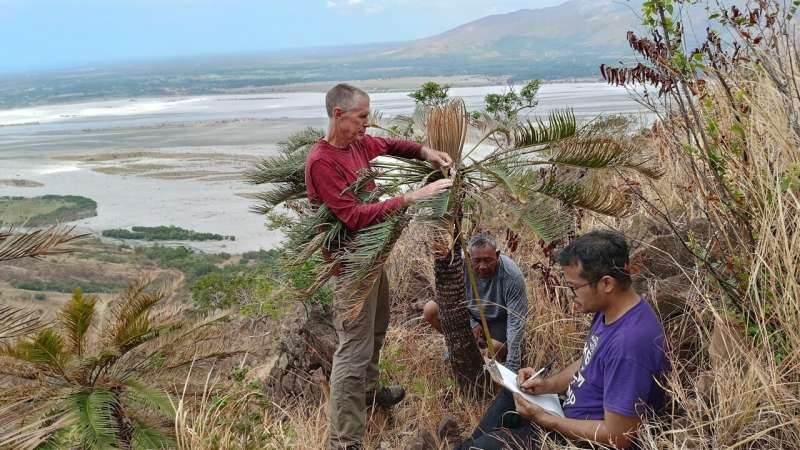This article has been reviewed according to Science X's editorial process and policies. Editors have highlighted the following attributes while ensuring the content's credibility:
fact-checked
trusted source
proofread
Study confirms A. yasumatsui as sole biotic threat to Micronesian cycad

A new study has confirmed that the invasive A. yasumatsui, known as Cycad Aulacaspis Scale (CAS), stands alone as the greatest threat to the existence of the Cycas micronesica species. The endemic cycad species to Micronesia has thrived in the region for 9,000 years but is now threatened with extinction following the arrival of the invasive scale in Guam discovered in 2003.
The study has been published in the journal Forests.
The University of Guam study spanned an eight-year period following the initial outbreak and involved a detailed look at demographic responses of the host cycad tree populations among six disparate sites in the Mariana Islands of Guam and Rota. The study found that the population-level responses of C. micronesica to the A. yasumatsui are remarkably similar among disparate habitats despite considerable variation in co-occurring biotic and abiotic conditions.
"We knew at the onset of our fieldwork that seedlings were the first to be killed by a new CAS invasion, so we were interested in determining if other stressors influenced how plant size interacted with the CAS damage," said Thomas E. Marler, retired University of Guam professor.
The research team monitored the movement of CAS among the two islands from 2003 until 2010 then selected the six study locations using a range of criteria, including the number of other cycad herbivores that were damaging the host plants along with CAS. When CAS was acting alone with no co-occurring herbivores, the plant population mortality responses were no different from when up to five other herbivores were threatening the host plants.
"The abiotic characteristics of the study sites were also different in numerous ways, and none of these habitat characteristics influenced the mortality outcomes," Marler said.
For example, plant mortality was similar despite elevations ranging from 6 to 364 meters above sea level, soils ranging from acid to alkaline, and habitats ranging from littoral to mountain.

CAS has emerged as one of the greatest threats to cycad conservation worldwide. The similarity of how the different plant populations responded to the CAS invasions in this study allowed the research team to develop models they claim can be used to predict the response of each new cycad habitat that is invaded by the deadly insect.
CAS has invaded the Japanese islands of Amami-Ôsima and Okinawa in recent months, and the canonical models may aid conservationists in predicting the plant population responses.
After one year of CAS herbivory, conservationists can expect none of the plants less than 20 cm in height, 96% of the plants 20-100 cm in height, and 100% of the plants greater than 100 cm in height to remain alive. After two years of CAS herbivory, the living population will consist of 52% of the plants from 20-100 cm in height and 76% of the plants above 100 cm in height. After three years of herbivory, the only remaining living plants will consist of 2% of the plants 20-100 cm in height and 38% of the plants above 100 cm in height.
This new knowledge will allow conservationists to collect plant size metrics in newly invaded habitats, then use the range of plant size categories to predict overall population mortality. For example, the Guam and Rota habitats in the study exhibited 94% mortality during three years of CAS herbivory. Applying the mortality models to the pre-invasion population structure would have predicted this mortality with high accuracy.
"Our main take-home message is that time is not on our side," Marler said.
In order to curb the increases in cycad plant extinction risks, establishment of efficacious biological control of the CAS population will be required without any delays whenever a new cycad habitat becomes invaded. The scientific community published this recommendation in 2005 for the Guam case study. To date, millions of dollars have been spent over two decades on mitigation actions that do not alleviate the primary CAS threat in any capacity.
"These findings implore conservationists in other geographic locations to learn from the unsuccessful example of the Guam invasion and take seriously the requirement to immediately establish biological control of CAS," Marler said.
More information: Thomas E. Marler et al, Insular Cycas micronesica Habitats Respond Similarly to Aulacaspis yasumatsui Invasion, Regardless of Co-Occurring Consumers, Forests (2023). DOI: 10.3390/f15010022
Provided by University of Guam



















